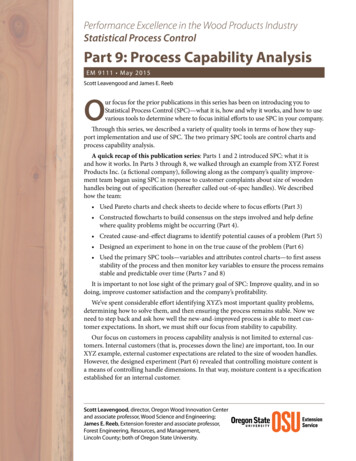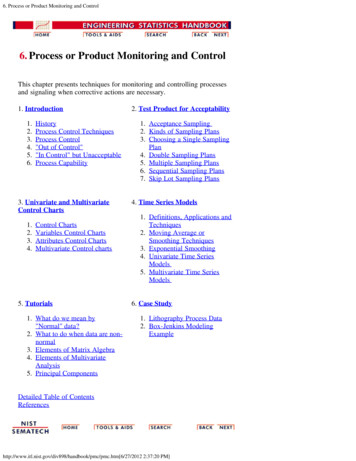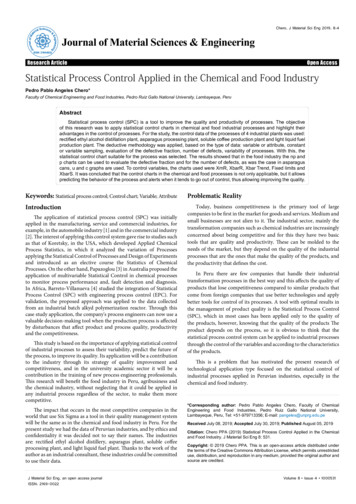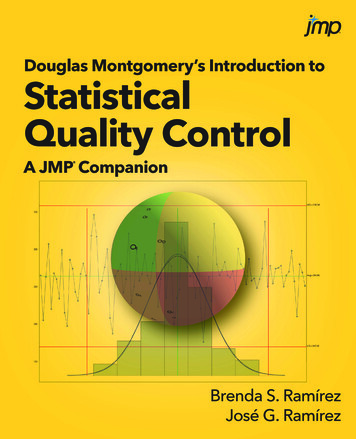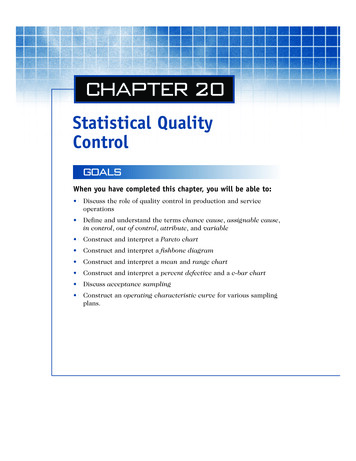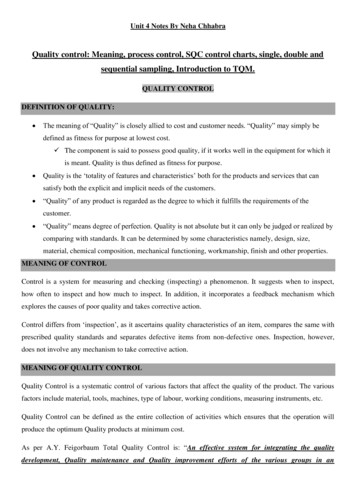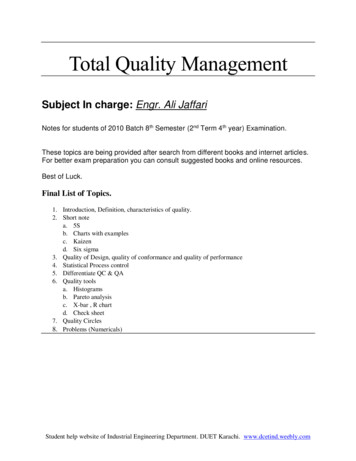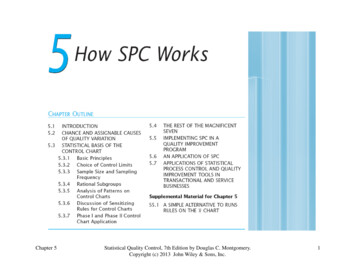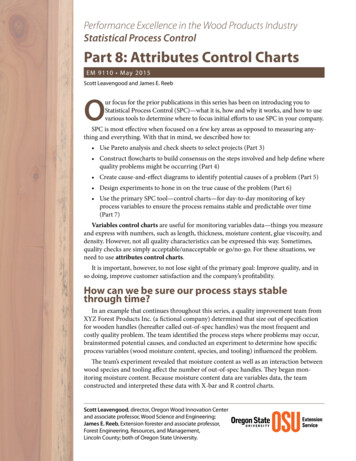
Transcription
Performance Excellence in the Wood Products IndustryStatistical Process ControlPart 8: Attributes Control ChartsEM 9110 M ay 2015Scott Leavengood and James E. ReebOur focus for the prior publications in this series has been on introducing you toStatistical Process Control (SPC)—what it is, how and why it works, and how to usevarious tools to determine where to focus initial efforts to use SPC in your company.SPC is most effective when focused on a few key areas as opposed to measuring anything and everything. With that in mind, we described how to: Use Pareto analysis and check sheets to select projects (Part 3) Construct flowcharts to build consensus on the steps involved and help define wherequality problems might be occurring (Part 4) Create cause-and-effect diagrams to identify potential causes of a problem (Part 5) Design experiments to hone in on the true cause of the problem (Part 6) Use the primary SPC tool—control charts—for day-to-day monitoring of keyprocess variables to ensure the process remains stable and predictable over time(Part 7)Variables control charts are useful for monitoring variables data—things you measureand express with numbers, such as length, thickness, moisture content, glue viscosity, anddensity. However, not all quality characteristics can be expressed this way. Sometimes,quality checks are simply acceptable/unacceptable or go/no-go. For these situations, weneed to use attributes control charts.It is important, however, to not lose sight of the primary goal: Improve quality, and inso doing, improve customer satisfaction and the company’s profitability.How can we be sure our process stays stablethrough time?In an example that continues throughout this series, a quality improvement team fromXYZ Forest Products Inc. (a fictional company) determined that size out of specificationfor wooden handles (hereafter called out-of-spec handles) was the most frequent andcostly quality problem. The team identified the process steps where problems may occur,brainstormed potential causes, and conducted an experiment to determine how specificprocess variables (wood moisture content, species, and tooling) influenced the problem.The team’s experiment revealed that moisture content as well as an interaction betweenwood species and tooling affect the number of out-of-spec handles. They began monitoring moisture content. Because moisture content data are variables data, the teamconstructed and interpreted these data with X-bar and R control charts.Scott Leavengood, director, Oregon Wood Innovation Centerand associate professor, Wood Science and Engineering;James E. Reeb, Extension forester and associate professor,Forest Engineering, Resources, and Management,Lincoln County; both of Oregon State University.
Variables or attributes: How to choosewhich to use?Whenever possible, it’s best to use variables data. Thistype of data provides more detailed and helpful information for troubleshooting and process improvement. Forexample: If the XYZ team uses digital calipers to measure handle size and discovers that variability of handlesize is acceptable but average handle size is 0.003 inchesover target, they would have useful information for howto adjust the process. Further, they might even determine that a mere 0.003 inches over target isn’t enough tobother with!On the other hand, if the team uses a go/no-go gauge,all they might learn is that the fraction of out-of-spechandles has increased. This is helpful but doesn’t provide enough information to know where to begintroubleshooting. Without further analysis, the team willnot know the direction (too big, too small, or both?)and magnitude (0.003 inches or 0.3 inches?) of thevariability.Also, sample sizes for attributes data are generally muchlarger. In fact, the lower the rate of nonconformities, thelarger the sample size must be. For example, if the ratedrops to 1 in 1000 and you are taking samples of 100items, the odds of seeing an out-of-spec part are verylow. The chart would simply be a flat line at 0, which isn’tvery helpful for process monitoring. This is a problembecause companies typically want to spend as little timeas possible collecting samples.However, there are situations where attributes data arethe only choice. Evaluating packaging appearance is agood example. Is the product labeled correctly? Is thelabel in the correct location? Is the packaging free ofgrease marks and forklift tracks? These are all yes/nodecisions. And in many situations, attributes inspectiondata already exist. Companies often have historical dataon defect counts that can be used to construct attributescontrol charts.2What if the team instead chooses tomonitor data such as handle dimensions, as they were doing when theyinitially identified the problem? Theycould measure handles with a custommeasuring device that has machineddimensions for the upper and lowerlimits for acceptable handle specifications. If the handle is too large to passthrough the device at the upper limitor small enough to pass through thedevice at the lower limit, it is considered out of spec. This type of device iscommonly known as a go/no-go gauge(Figure 1).Instead of taking a sample of fivehandles and obtaining moisture content data (e.g., values of 6.5%, 7.1%,etc.), the team might take a sampleof 50 handles every few hours, checkthem with a go/no-go gauge and discover that five are out of spec. Thistype of data is not suitable for variablescontrol charts, but the team still needsto analyze the data and determinewhether variability in the process iswithin the expected range. For this situation, an attributes control chart is thetool to use.Figure 1. Example go/no-go gauge.Image used with permission fromhttp://www.maximum-velocity.com/7530.htm
Attributes control chartsThere are several types of attributes control charts: p charts: for fraction nonconforming in a sample; sample size may vary np charts: for number nonconforming in a sample; sample size must be the same u charts: for count of nonconformities in a unit (e.g., a cabinet or piece offurniture); number of units evaluated in a sample may vary c charts: for count of nonconformities in a unit; number of units evaluated in asample must be the sameOf these chart types, the p chart is the most common in the wood products industry. Therefore, this publication focuses on how to construct and interpret p charts. Seethe resources listed in the “For more information” section at the end of this publication for details on the other chart types.Like variables control charts, attributes control charts are graphs that display thevalue of a process variable over time. For example, we might measure the numberof out-of-spec handles in a batch of 50 items at 8:00 a.m. and plot the fraction nonconforming on a chart. We would then repeat the process at regular time intervals.Attributes control charts include points (in this case, the fraction nonconforming1 ina sample), a centerline that represents the overall average of the variable being monitored, and upper and lower limits known as control limits.Many details about using p charts are identical to what we described in Part 7 forvariables control charts. So let’s return to our example and see how the XYZ team constructed and interpreted a p chart.Example: XYZ Forest Products Inc. uses anattributes control chartCollect dataPreviously, the quality improvement team at XYZ Forest Products Inc. designed anexperiment and used a go/no-go gauge to measure size out of specification for batchesof 50 handles made with all combinations of poplar and birch at 6% and 12% moisturecontent, and with existing and new tooling. Each combination was run five times (fivereplicates). That amounts to eight combinations of species, moisture content, and tooling and 40 batches (2000 handles!). Table 1 repeats the results of that experiment.As discussed in Part 3, the terms nonconforming and nonconformity are typically preferred over the terms defectiveand defect. A nonconforming product fails to meet one or more specifications, and a nonconformity is a specific typeof failure. A nonconforming product may be termed defective if it contains one or more defects that make it unfit orunsafe for use. Confusion of these terms has resulted in misunderstandings in product liability lawsuits.13
Table 1. Experimental results—raw 44012newpoplar31Tooling SpeciesTooling SpeciesMoisture content.Can the team use these data to create a p chart? Certainly. However, in practice,we need another critical piece of information: order of production. Remember thatcontrol charts are intended to display the results of samples taken from a productionprocess as they are being produced.Because good experimental design calls for randomizing the sequence of the runs2,the results in Table 1 are probably not in sequence. But for the sake of this discussion,we will assume the data are in sequence (that is, batch 1 was run at 8:00 a.m., batch 2at 9:00 a.m., and so on).If the outcome could be affected as a result of timing or sequence of runs (such as dulling of the tool), differences inresults between early and late batches are likely to be due to timing as much as to the variables being tested. Therefore,it is good practice in experimentation to randomize the order of the runs.24
Analyze dataData analysis for p charts is simpler than that for variables control charts. For eachsample, we simply need to calculate p (the fraction nonconforming in the sample) bydividing the number nonconforming in the sample by the sample size.For batch 1, this is: 5/50 0.1 (10%)For variables control charts, we use one chart to monitor the average (X-bar chart)and another to monitor the variability (range or R chart). There is only one chart forp charts.As with variables control charts, we plot data on a p chart with a centerline andcontrol limits that are plus and minus three standard deviations from the average. Thecenterline is the average rate of nonconforming product. The average fraction nonconforming on a p chart is represented by the symbol p (p bar). In our XYZ example,there were 216 nonconforming (out-of-spec) handles out of 2000 measured.p 216/2000 0.108 (10.8%)This means that size was out of specification for about 10.8% of samples. Now, weneed to estimate the standard deviation of p to calculate the control limits.Calculate control limitsIn Part 7, we discussed the normal distribution for variables control charts indetail. For p charts, the underlying statistical distribution is known as the binomialdistribution. The binomial distribution is the probability distribution of the numberof successes in a sequence of independent conforming/nonconforming (yes/no)experiments, each of which yields success with probability p.From statistical theory, we know that the standard deviation (s.d.) of a binomialvariable p is:where n is the sample size (50 in this example). Therefore, the three-standard-deviation control limits for a p chart are:where n is the average sample size (50 for this example, since all the batches were ofsize 50). Therefore, the centerline is 0.108 (the average fraction nonconforming of allthe samples). The upper control limit is 0.240. Since the lower control limit is negative,it is set to zero (the cluster of three dots at the end means “therefore”).5
Construct and interpret p chartConstruct p chartFigure 2 shows the p chart for the data in Table 1. Now we need to decide what thechart means and what it can tell us about the process. Remember: Our primary interest is process stability and consistency.In Part 7, we discussed common-cause and assignable-cause variability. Commoncause variability is inherent to the process. Assignable-cause variability is anindication that something has changed. We use control charts to decide which type ofvariability is present.If there is evidence of only common-cause variability, we may conclude that theprocess is in control (stable). However, if there is evidence of assignable-cause variability, we conclude that the process is out of control (unstable). If the process is outof control, we must take action to return stability to the process.What are the indicators of assignable-cause variability? As with variables control charts, a point beyond the control limits is a first-level indicator and a sign thatwe should take action. Other indicators of an out-of-control process are known asthe Western Electric Rules because they were developed by the Western ElectricCompany and published in their Statistical Quality Control Handbook (1956). Theserules are summarized in Table 2. The rules for p charts are different than those forX-bar and R charts because the charts have different underlying statistical distributions (binomial distribution and normal distribution, respectively).Table 2. Western Electric Rules for interpreting patterns on p chartsRuleDescription1Any point outside of the control limits29 points in a row above or below centerline36 points in a row steadily increasing or decreasing414 points in a row alternating up and downThe more rules you apply, the higher the chances of false alarms. As always, thereare trade-offs. For processes that are critical to quality, it makes sense to apply all therules at the expense of a few false alarms. For processes that are less critical, perhapsonly Rule 1 might be used.Figure 2. p chart for data in Table 1.6
Examine p chartLook again at Figure 2. There are no points beyond the upper control limit.Therefore, Rule 1 is not violated. In fact, none of the four rules listed in Table 2 areviolated—although we come very close. For example, beginning at Sample 28 there areeight points in a row above the centerline. And there are several places with five pointssteadily increasing or decreasing (and the sixth point is often the same as the fifth).Therefore, the XYZ team should proceed with caution before assuming this process isin control.On a p chart,points below the lowerlimit are a good thing!They indicate theprocess has improved.Interpret p chartAt this point, we must stop and consider the nature of these data. Remember: Thesedata are from experimental runs. The team deliberately varied the species, moisturecontent, and tooling. Therefore, we should expect this process to be in control only ifthere are no significant effects due to species, moisture content, and tooling.But during the designed experiment, there was statistical evidence of a differencein the number of out-of-spec handles due to moisture content and an interactionbetween species and tooling. In other words, the designed experiment revealed thatthis is not a stable, consistent process. Therefore, we should expect some evidence ofinstability (out of control) to appear on the p chart.So why don’t we see strong evidence of lack of control? One reason is that the differences are not dramatic. Also, p charts aren’t very sensitive unless samples sizes arevery large, the nonconforming rate is high, or both.One important note: Remember that these are fractions nonconforming in asample. If the process goes out of control above the upper control limit, that is anindication that the defect rate has increased. But what if the process is out of controlon the low side? For example, what if there are nine or more points in a row below thecenterline or the lower control limit is below zero (the lower limit)? This is actually agood thing! It indicates that the defect rate has decreased. Either way, we must investigate to determine the cause. For an increasing defect rate, we need to identify andcorrect problems. For a decreasing rate, we need to determine what went right andhow to sustain this improvement.The np attributes control chartThe np chart is another type of attributes control chart. The main difference between the np chart and pchart is the rules regarding sample size. For np charts, the sample size of each subgroup must the same.This situation is applicable to the data in the XYZ example. The batch size was 50 for all 40 samples. Sowe could plot data from Table 1 on an np chart. The np chart would look identical to the p chart, and theinterpretation would be identical as well.The main difference would be in the scale. Rather than plotting the fraction nonconforming, we wouldplot the number nonconforming (np). The centerline would be the average number of nonconformingitems over the 40 batches (5.4, in this case). The formulas for control limits on np charts are similar tothose for p charts:On an np chart for the data in Table 1, the upper control limit would be 12. As with the p chart, thelower control limit would be zero.7
Next stepsOnce the process exhibits control (on a variables control chart, attributes controlchart, or both) for a reasonable amount of time, can the XYZ team be confident thatthe size-out-of-spec problem will go away? Unfortunately, it’s not that simple.When analyzing a p chart, what is an acceptable level of nonconforming items? Isn’ta single out-of-spec handle one too many? As the team starts considering acceptablequality levels and determining how the process variability compares with customerexpectations, they must shift out of the domain of control charts.Control charts help determine whether processes are stable and if so, at what targetvalue and variability. To compare processes to customer expectations (specifications),the XYZ team will need to turn their attention from process stability to processcapability.The next publication (Part 9) in this series will focus on another area of SPC: processcapability analysis.Where to use attributes control chartsIn your company, where could you use attributes control charts? Any area whereyou are doing some type of inspection and making good/bad or yes/no decisions is acandidate. Common examples in the wood products industry include: Packaging: Correct label placement, correct label details (e.g., if the packagesays ¾" oak, is it really ¾" oak?), legible label, correct number and placement ofbands on a unit. Sticker placement: For dry kiln operations, kiln stickers are the pieces of wood(often about the size of a 1 2) that are placed between layers of lumber to allowfor airflow in the kiln. Some companies use p charts to track correct placementand alignment of the stickers. Procedure: Hold up a straightedge to cover thestickers and count the number of stickers not covered by the straight edge (i.e.,those that are out of alignment) as well as those that are missing altogether. Finished unit inspection: For items such as cabinets and furniture, companiesoften do a final inspection of the appearance of the finish, placement ofhardware, presence/absence of additional hardware, and correct placement ofprotective corner blocks. A c chart or u chart may also be appropriate in thesesituations when there are multiple items inspected on a single unit (i.e., cabinetor table).8
For more informationThe Oregon Wood Innovation Center website provides common table values for SPC:http://owic.oregonstate.edu/spcThe listing for this publication in the OSU Extension Catalog also includes asupplemental spreadsheet file that includes the data and chart from this edu/em9110Brassard, M., and D. Ritter. 2010. The Memory Jogger II: A Pocket Guide of Tools forContinuous Improvement & Effective Planning. Methuen, MA: Goal/QPC.http://www.goalqpc.comGrant, E.L., and R.S. Leavenworth. 1996. Statistical Quality Control (7th edition). NewYork, NY: McGraw-Hill.Montgomery, D.C. 2012. An Introduction to Statistical Quality Control (7th edition).New York, NY: John Wiley & Sons.Western Electric Company Inc. 1956. Statistical Quality Control Handbook.Milwaukee, WI: Quality Press.About this seriesPublications in the Performance Excellence in the Wood Products Industryseries address topics related to wood technology, marketing and businessmanagement, production management, quality and process control, andoperations research.For a complete list of titles, visit the Oregon State University ExtensionCatalog and search for “performance e.edu/Trade-name products and services are mentioned as illustrations only. This does not mean that the Oregon State UniversityExtension Service either endorses these products and services or intends to discriminate against products and services notmentioned. 2015 Oregon State University.Extension work is a cooperative program of Oregon State University, the U.S. Department of Agriculture, and Oregoncounties. Oregon State University Extension Service offers educational programs, activities, and materials withoutdiscrimination based on age, color, disability, familial or parental status, gender identity or expression, genetic information,marital status, national origin, political beliefs, race, religion, reprisal, sex, sexual orientation, veteran’s status, or because allor a part of an individual’s income is derived from any public assistance program. Oregon State University Extension Serviceis an AA/EOE/Veterans/Disabled.Published May 2015.
Statistical Process Control Part 8: Attributes Control Charts O ur focus for the prior publications in this series has been on introducing you to Statistical Process Control (SPC)—what it is, how and why it wo
